Mobile applications are the undisputed panacea for businesses to leverage seamless connections with clients and prospects. With interactive communication and enhanced adoption of new products & services, mobile apps have become synonymous with marketing strategies. You must know the present and future trends to absorb the benefits fully. Here’s an overview of what you can expect.
How many Apps do you have on your phone? Have you noticed? A new feature every day. An increased customer base for businesses each moment. Innumerable expectations from a never-ending stream of users. All, a reflection of the break-neck speed evolution in the mobile app development industry. A glimpse at the following data will confirm this.
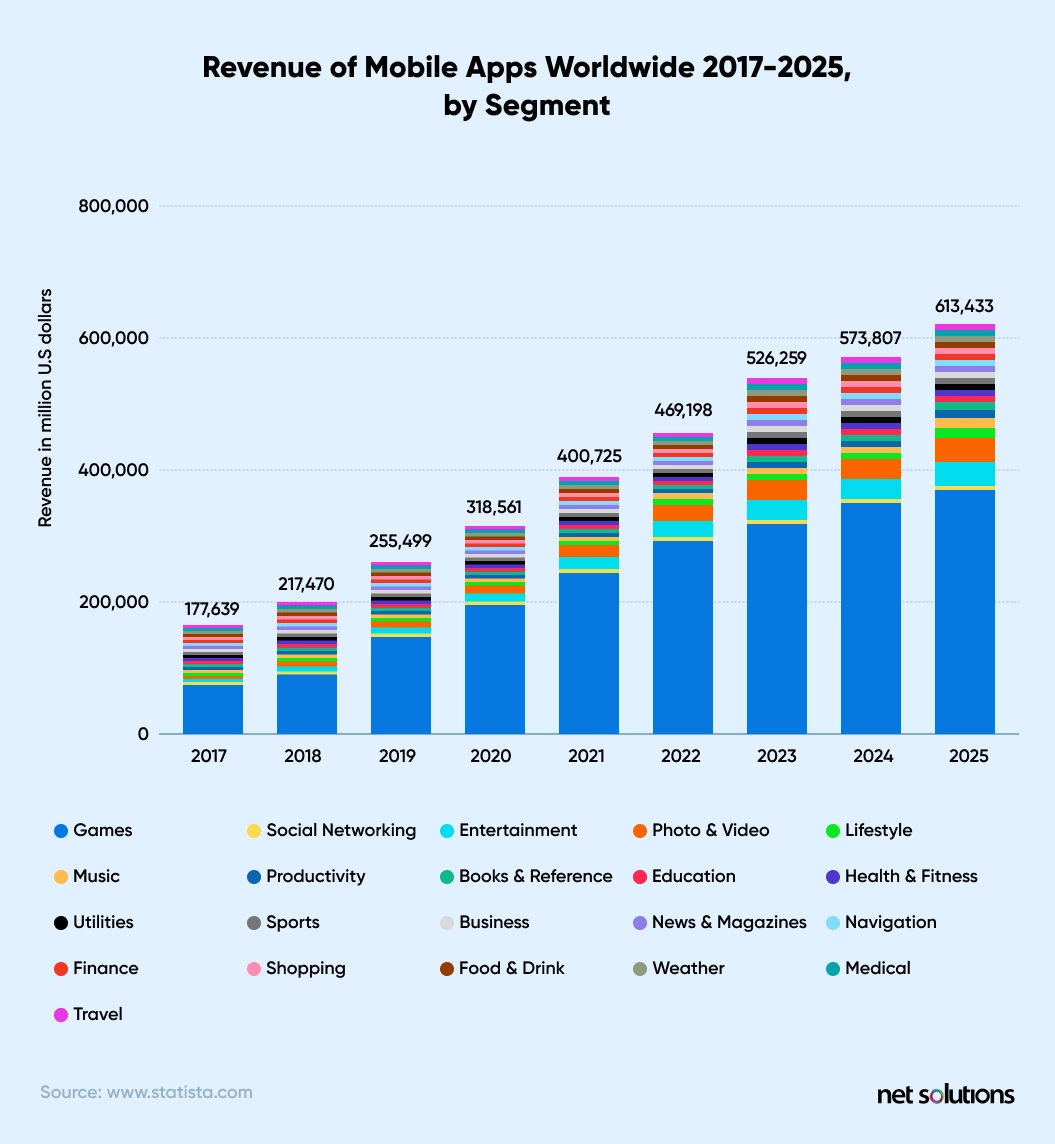
The Statista Digital Market Outlook estimates that revenue across most segments will increase over the next few years and reach around 613 billion U.S. dollars by 2025.
There are 6.63 million apps on Google and the Apple App Store combined. How would you make sure your app stands out? The truth is you can’t unless you stay abreast with the latest mobile app development trends and know how to leverage them to deliver robust, feature-rich apps. The mobile app development industry is evolving at a break-neck speed. To survive and thrive in this digital Darwinian era, you must get acquainted with the changing mobile app development trends.
However, another scary truth is most mobile apps fail. The inability to track and implement the latest mobile app technology trends is the primary reason for this failure. This shortcoming also results in losing out to a more technologically adaptable competitor. Working and implementing a few mobile app development tips can improve your app considerably.
The first step forward is to stay updated with future mobile app development trends to make your mobile app a success. Let’s discuss some of these latest trends in detail.
What are the Top Mobile App Development Trends for 2025?
While a lot of new trends in mobile app development are emerging this year, here are the top 14 mobile app development trends that we picked after elaborative, fact-based research.
- Rise of 5G The 5G technology has been around for a while. But this year, it has become a buzzword. Technology companies have started incorporating 5G at full scale, and we see 5G-enabled devices in the market. By next year, it is expected that 660Mn smartphones will have 5G connection which accounts to around 47.5% of all devices.
Take a look at how 5G connections worldwide are projected to grow in upcoming years.
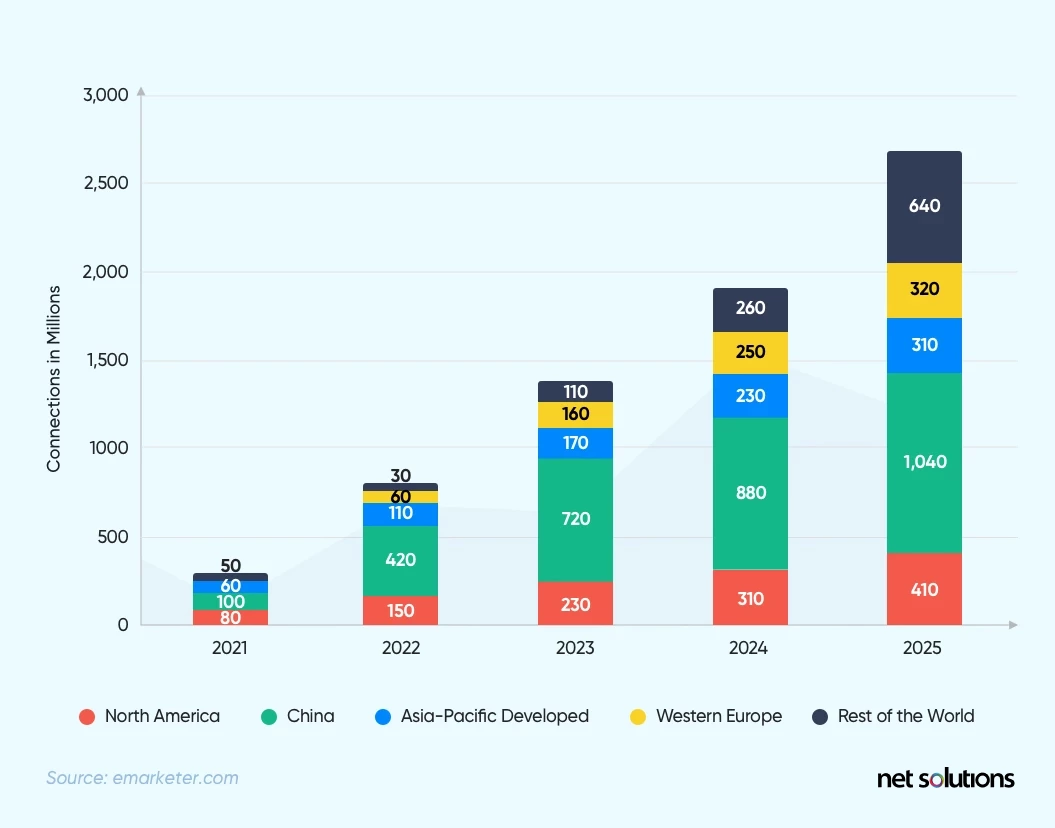
What does the rise of 5G mean for App Development?
5G will change the way we build and use apps. Speed and efficiency will significantly improve. Here are a few things we can expect:
- 5G will be up to 100x faster than 4G.
- Latency will reduce from 50 milliseconds (4G) to 1 millisecond.
- With higher resolution, less latency, and faster performance – video streaming apps will see a significant improvement.
- 5G will bring more opportunities for AR and VR as integrating these technologies into the app will be easier.
- Transferring data between devices and smartphones will be faster and smoother.
- 5G will allow Developers to build new features without negatively affecting the mobile app performance.
- Mobile payments will be quicker and more secure because of the faster processing of biometric data for identification.
Overall, the 5G technology will make apps faster, smoother, and more efficient. It will also open rooms for innovation. All the exciting ideas you might have about your app will no longer remain ideas. With 5G, you can make them a reality. We can’t wait to see what the technology brings onboard.
- Apps for Foldable Devices Although foldable devices are the tip of the overall smartphone market share, things will change in the coming years. So, it’s time you also keep foldable devices in mind while planning out your mobile app development strategy. Make sure your apps run seamlessly on foldable devices — a challenging mobile app development trend in 2025.
Unfolding the device to provide a larger screen can have a positive impact on users:
- A larger screen means more space for a detailed and immersive experience.
- With multi-windows, a user can perform multiple tasks at the same time.
Video streaming and gaming apps can reap maximum benefits from the foldable devices by simply increasing their screen size – or instead, using the extra space to offer additional information and controls. Thus, developing the apps keeping the screen in mind will be one of the biggest mobile app development trends in 2025.
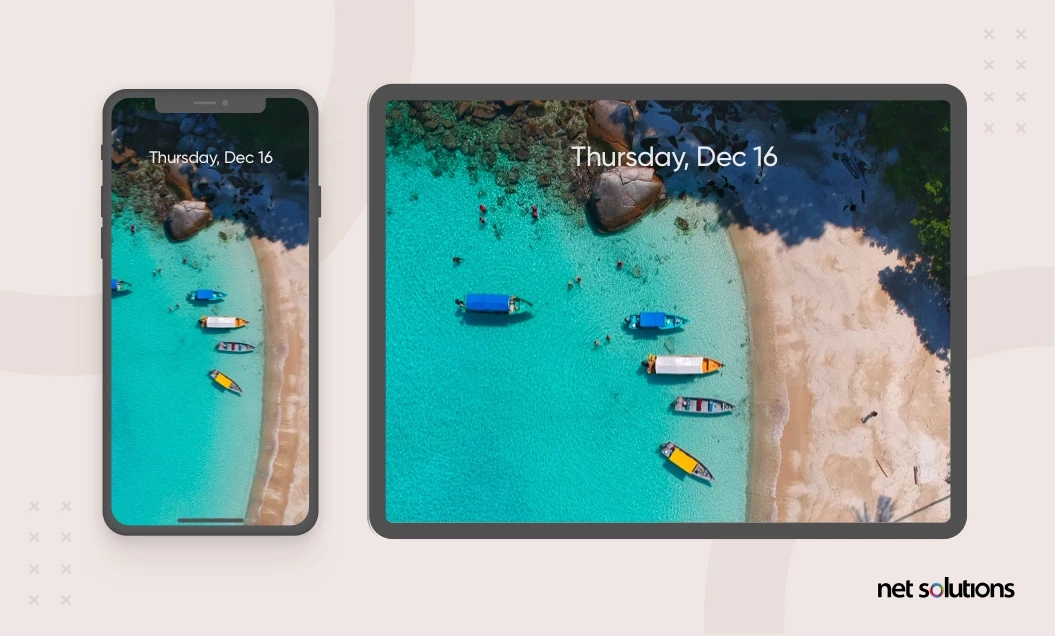
- AR & VR The success of Pokemon Go may have been temporary, but it paved the way for AR in mobile app development. It showed the world that we could practically use VR to offer an immersive experience to users. Today, if we look around, we can find many scenarios in which brands use AR & VR to user experience.
- Ikea uses AR to let users see how furniture will look at their home before buying it.
- L’Oreal has a virtual makeup app that allows users to see how the makeup looks on their faces.
- Lenskart lets users virtually try glasses before buying them.
Even Apple, Google, and Meta are bringing innovations in AR & VR. Google introduced a feature called “Live View” in Google Maps, where users can see the direction in real-time on real-world imagery.
LiDAR is another significant technology advancement we have recently seen in the field of AR. Called AR at the speed of light by Apple – we saw the technology making its debut in iPad Pro, iPhone 12 Pro, and iPhone Pro 12 Pro max. It has taken AR into a whole new level. With LiDAR, it has become possible to capture superior quality photos in low light.
Apple has even revolutionized the furniture shopping process by partnering with Ikea to launch a new Studio Mode feature that uses LiDAR technology. Using the feature, users can point their device to the place where they want to place the furniture and the LiDAR technology will scan the room to virtually place a true-to-scale furniture model.
This year, we will see AR & VR shaping the mobile app development industry in ways we can’t even imagine. The mobile app trend will go more mainstream.
We’ll also see a spike in the number of AR & VR users this year. It means you have a great chance to leverage these mobile app development trends to bring game-changing experiences to users on mobile.
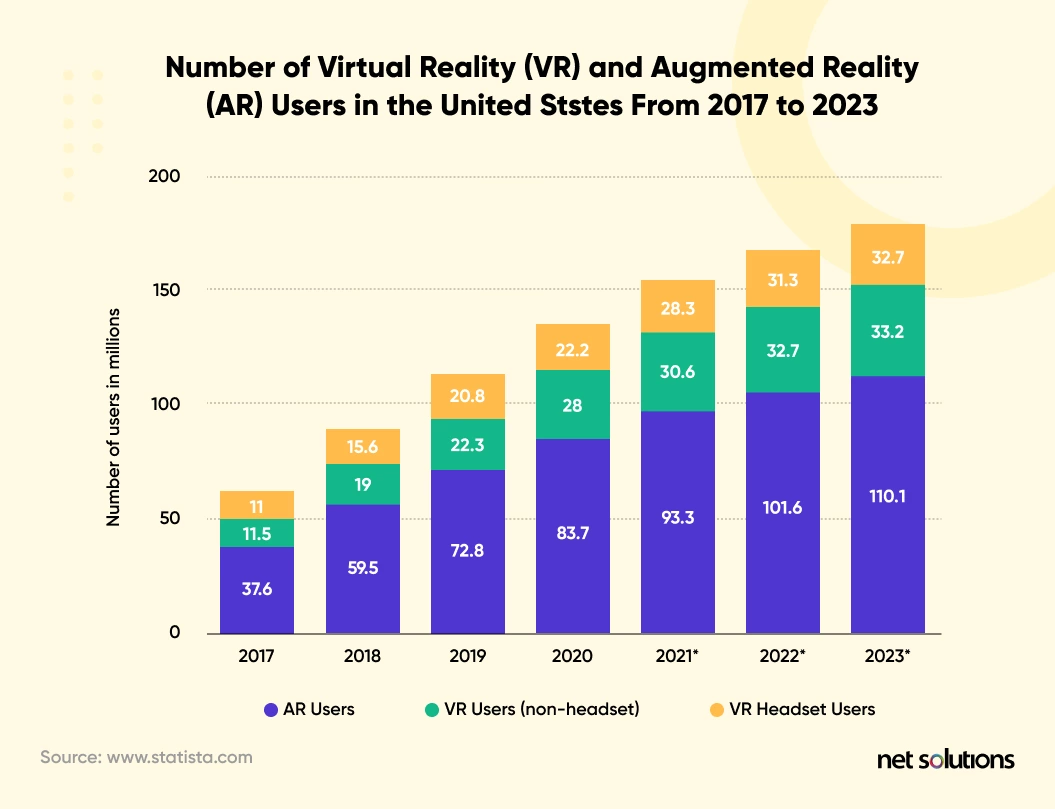
- Wearable App Integration Wearable devices are already ruling the world. According to Statista, connected wearable devices reached 453 million in 2017 and 929 million in 2022.
This year we saw many important things happening in the wearable devices industry. Apple announced its WatchOS 8 update. It brought new features, fresh watch faces, increased wallet access, and redesigned interface for Apple watch users.
Even Google announced a unified wearables platform that blends its wear operating system with Samsung’s Tizen software platform – boosting app startup times by 30%.
It signifies the rise in wearable technology — one of the essential mobile app development trends in 2025.
In other words, app developers and businesses should get ready with apps that provide an excellent digital experience to users on Smartwatches and wearables, thus gaining a distinct edge over those who do not.
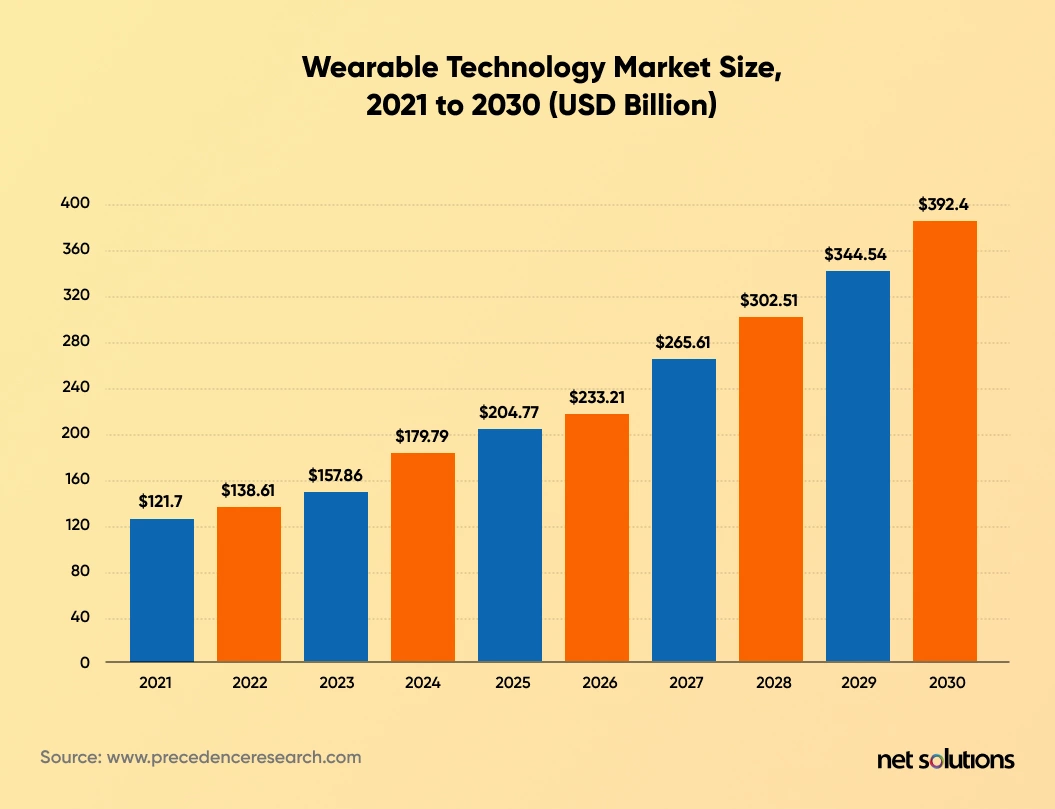
Embrace this mobile app development trend and get close to your target customers by offering them a seamless digital experience.
- Food & Grocery Delivery Apps People started relying heavily on apps like Instacart and meal kits as they stayed at home following the lockdown. As a result, these two have been some of the fastest-growing app categories over the years.
- The entire food delivery app industry is expected to reach a $320 billion market size by 2029
- Uber Eats is the most popular food delivery app; Delivery Hero has the most collective users
- In the US, DoorDash is the most popular food delivery app, with over 50% market share
- Digital grocery sales in the US are estimated to reach $59.5 billion by 2023
We may see a slight decline in their growth as we go back to normality. Food and grocery apps will still be a critical part of our lives. People will never stop ordering food online, and the Grocery apps will still account for 15.5% of smartphone users.
Anyways, only time will tell. But it will be interesting to see what road food and grocery delivery apps take in 2025.
- Mobile Entertainment & Gaming Entertainment and gaming apps have become a part & parcel of lifestyle. Some people can’t even imagine spending a single day without them.
We can guess the popularity of mobile entertainment apps as Netflix has around 74% active subscribers in the US and Canada. Besides this, the number of mobile phone gamers is expected to reach 162.8 in 2023; mobile devices are the favorite among gamers – amounting to almost 90% of US digital gamers.
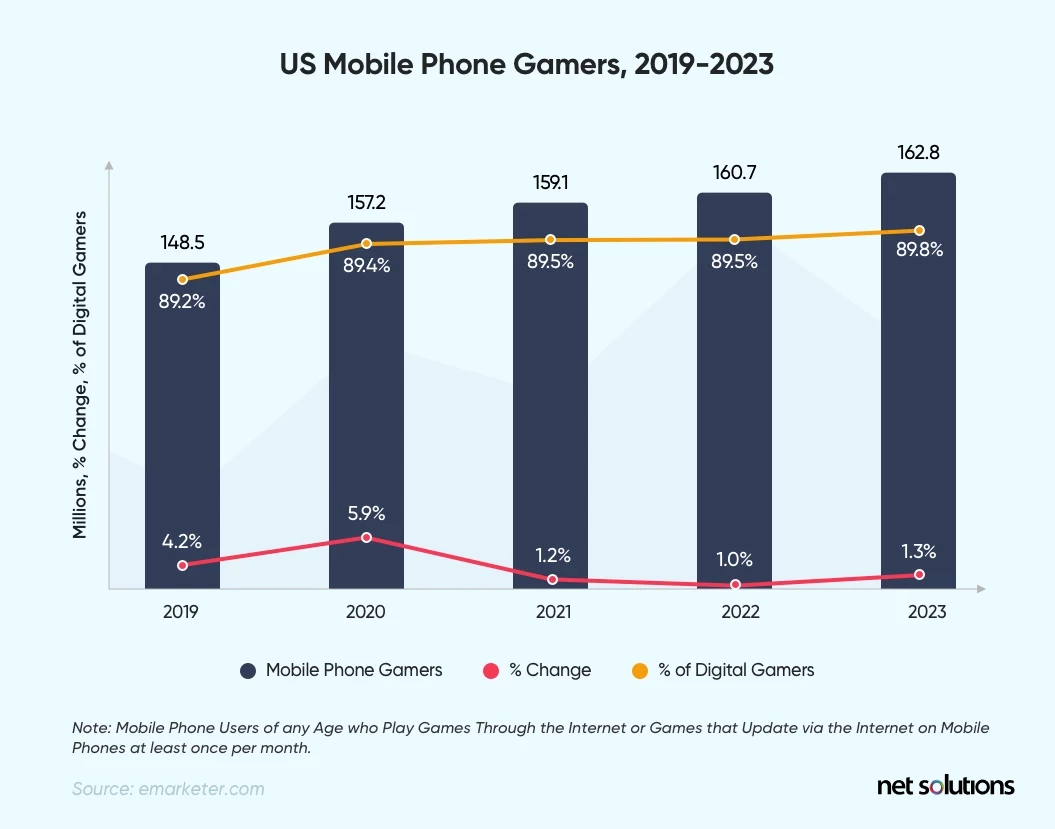
Why are Mobile Entertainment & Gaming Apps so Popular?
- They have provided easy access to entertainment. People no longer have to buy expensive gadgets or even expensive laptops. Instead, they can enjoy them on mobile.
- Users no longer have to confine themselves to one place to watch a movie or play a game. Instead, they can entertain themselves on the go.
- Technological advancements like AR, VR, and artificial intelligence have made games & entertainment apps more immersive.
- Mobile Entertainment & gaming apps provide a great escape. Especially during the pandemic, people spent time on games and entertainment apps to distract themselves.
- AI & Machine Learning After the ground-breaking success of FaceApp, most of the folks were wondering: What’s next? That’s when AI brought something that propelled my expectations to a whole new level. The MyHeritageApp brought a powerful photo animate feature that converts pictures into realistic animations. These animations are so impressive that you feel your loved one is smiling at you. It resulted in some epic reactions.
It is not the only exciting thing that happened in AI last year. We also saw Google launching new features to its Maps app that uses AI to enhance user experience. One such feature is Live view that offers users AR navigation in large indoor spaces. Google also uses AI to suggest less carbon-intensive routes by optimizing directions for lower fuel consumption.
AI and ML have been amongst the top mobile app development trends for the last few years in a row. But these technology advancements set the bar for mobile app development for 2025 very high, and it will be interesting to see what it brings to the table this year.
Machine learning is another exciting field in which we’re waiting to see revolutionary things happening. When Deep Learning joins hands with ML, it can do wonders for mobile app development projects by providing valuable data and real-time analytics.
The global ML industry, growing at a CAGR of 42 percent, will be worth almost $9 billion. – Machine Learning in 2019
Apple has been one of the key players in machine learning. Its intelligent ML models have allowed developers to create immersive new experiences. Not only can you easily add pre-existing features, but you can also create new ones. Besides, you can add new features with ML APIs.
This year, we suggest you get deeper into these technologies and get acquainted with their features properly and many of their components.
- There Will be More Focus on Mobile App Security According to Check Point State of Mobile Security 2021 report, around 46% of organizations had at least one employee who downloaded a malicious mobile application. Given how much employees depend on mobile devices, it’s a matter of concern for businesses.
That’s why most businesses are looking to invest more in cybersecurity, given it is directly linked to data protection and information privacy laws. Thus, digital security has emerged as one of the top mobile app development trends in 2025. The finest minds in the industry are levelling-up the ante to draw out the uncertainty around mobile apps. In WWDC 2021, Apple took the first step to a password-less future by introducing a new feature called “Passkeys in iCloud Chain.” With it, Apple will replace passwords with a more secure login process.
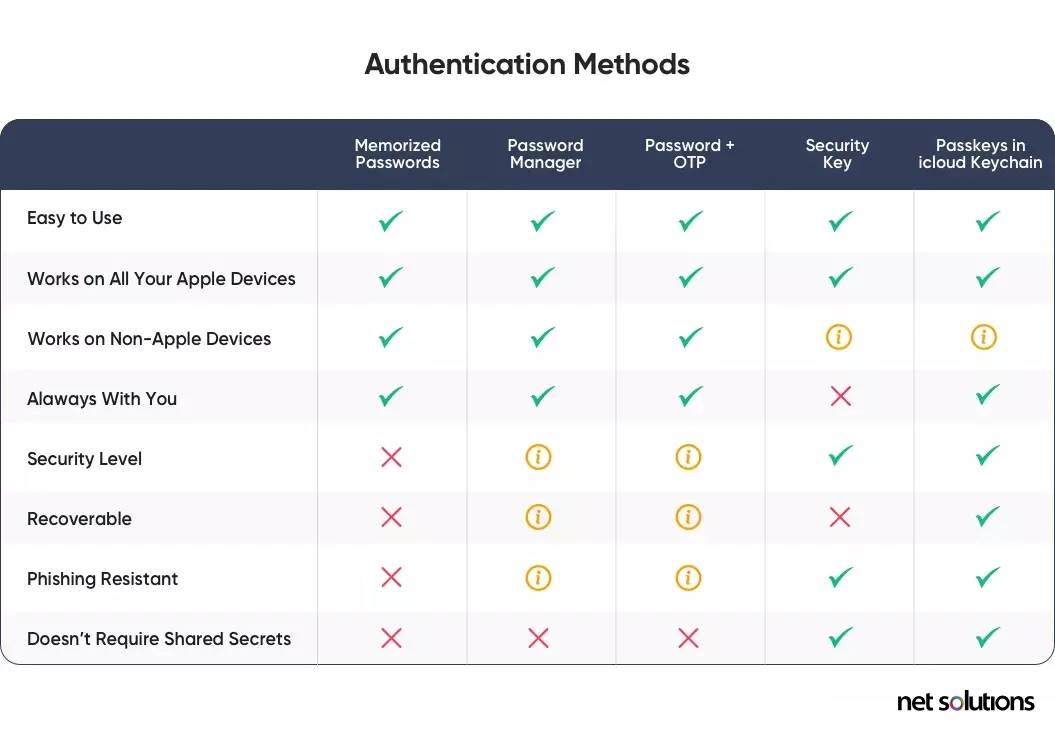
In 2025, the mobile app development industry is expected to witness a shift towards the security-first approach, thus laying the roadmap for a robust DevOps Strategy.
- Super Apps One app, one purpose – it has been the approach of mobile app development companies for years. But now, the approach is changing.
Companies are shifting from single-purpose apps to one-stop solutions that solve multiple purposes.
Such apps are called Super Apps, and they are insanely popular in Asia. However, the trend is also catching up in the west. One interesting example in the US market is Natural AI developed by California-based company Brain Technologies Inc. It strives to change the way people interact with their phones allowing them to solve multiple purposes from a single app.
Besides, you might have observed how Facebook has extended from just being a social media platform. It is now also offering marketplaces where people can buy and sell products. Similarly, you can now also pay bills and make payments from Amazon apart from online shopping.
The craze about super apps is not that high in the western world, as people prefer trying different solutions before settling on one. Still, convenience is what everyone seeks in the end. So, super apps are a mobile app development trend we should look forward to in 2025.
- Mobile Commerce The Ecommerce sector is responsible for sales worth $3.56 trillion, and 72.9% of these sales happen on mobile. Hence, mobile commerce is a rising app development trend.
We saw a significant lifestyle shift after the COVID pandemic. From large retailers to small businesses and individual consumers, everyone has started relying on mobile apps.
It puts Ecommerce businesses that fail to adapt at a disadvantage. They are losing a lot of customers and missing out on ones they could convert.
Hence, businesses need to adapt to this trend and have an eCommerce business app. It is the only way they can survive the cut-throat competition.
However, mobile commerce being a buzzword should not be the only reason you have an app for your business. There are many other reasons that we have elaborately covered in the blog on why you need an Ecommerce business app. You must check it out.
- P2P Mobile Apps P2P mobile apps are another key trend that will mark the mobile app development sector. According to eMarketer, the projected worth of P2P mobile transactions reached $612.23 billion by 2023. It means there is a huge scope for P2P mobile apps at present.
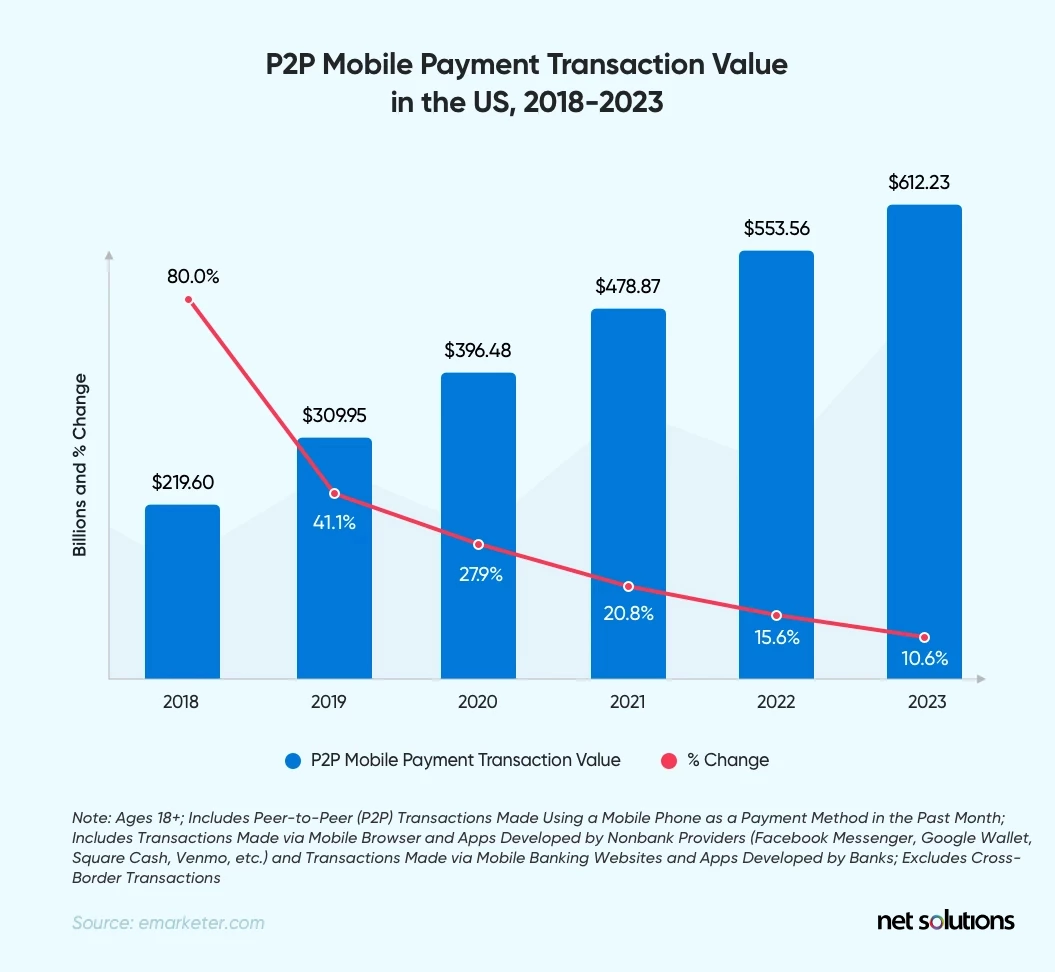
Convenience is why P2P mobile apps are amassing popularity among businesses and users. Users can quickly pay, while sellers can directly receive payments into their account. Hence, there is no unnecessary hassle.
Here are some types of P2P mobile apps that we can see around us this year:
- Social media platforms with built-in payment features.
- Mobile OS systems with built-in systems for payments. Examples are Apple Pay, Samsung Pay, Android Pay.
- Independent providers who are offering their own payment systems.
- P2P apps that involve a bank as a party to payment.
- Cryptocurrency wallets.
If you have a P2P mobile app idea, there is no better time to bring it to reality.
- Blockchain We first heard about Blockchain during the cryptocurrency boom. But now the technology has come a long way and is applicable in different areas. It is growing at a significant rate, and is expected to accumulate $20 billion in revenue by 2025. Blockchain is also playing a pivotal role in mobile app development.
Decentralized apps are a thing these days. There are over 70 million blockchain wallets out of which mobile wallets are the most preferred blockchain wallet form. These stats also show how the number of blockchain wallet users is significantly increasing.
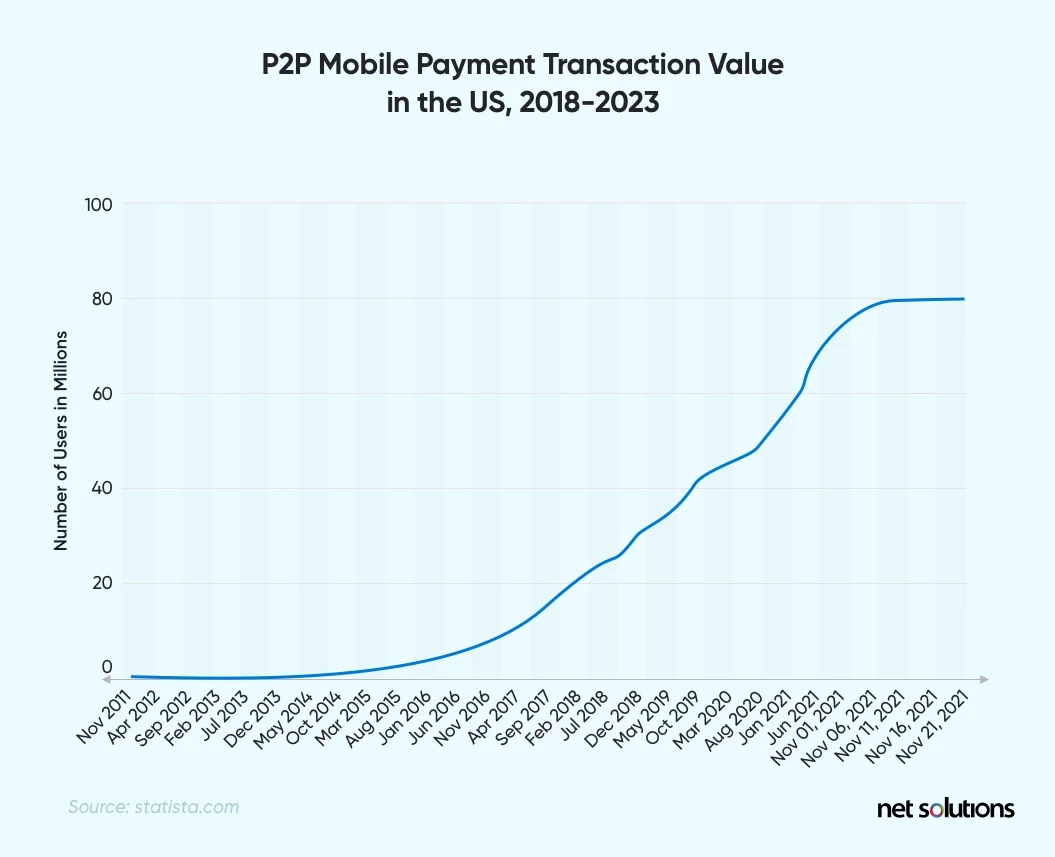
Besides, we also see currency converters that use Blockchain to track digital assets, secure digital identity, and keep track of loyalty programs.
In 2025 and beyond, we see the trend going more mainstream with intelligent contracts, anti-piracy software, tools to moderate elections, and Blockchain as a service (BaaS) platforms. Especially in mobile commerce and mobile payment apps, we can use Blockchain to prevent frauds from happening.
- Predictive Analytics Enterprises have been using predictive analytics in mobile apps for some time now. Netflix uses it to recommend movies and TV shows based on users’ watching habits. Also, Amazon leverages predictive analytics to personalize product recommendations.
This year, we’ll see predictive analytics going more mainstream. Here are two areas where we can see the trend playing a crucial role in mobile app development in 2025:
- To Optimize the Development Process: Enterprises can process the data gathered from developers to discover issues before they occur and suggest better alternatives.
- To improve the User Experience: Businesses can use user data to predict the user’s actions and personalize their journey.
As a result, we can significantly reduce the development time while keeping the quality excellent and focusing more on delivering innovations.
- Mobile Learning According to Statista, 35% of employees frequently use their mobile devices to learn. Also, the mobile learning market is expected to reach $58.50 billion by 2025, promising a CAGR of 21.45% over 2020-2025. Hence, mobile learning is a promising trend that will change the face of mobile app development.
Mobile learning is famous for many reasons. First, it makes learning easily accessible. Learners feel empowered as they can learn from anywhere and anyone. Moreover, experiences like continuous feedback and 360-degree learning have made learning interactive and fun.
Even enterprises are now favoring mobile learning, as it leads to better course completion rates, faster learning, higher engagement, and better knowledge retention.
So, the demand for mobile learning apps is high. If you have a ground-breaking idea or a plan to launch a mobile learning solution to train your employees, this is the right time to contact a team that specializes in education app development.
- IoT-Enabled Mobile Apps The internet has crawled deep into our lives. From smartphones, laptops, and tablets to voice-controlled smart home devices – we are surrounded by devices connected to the Internet. The Internet of Things (IoT) has become a lot more than just a trend.
In the last few years, we saw brands like Amazon and Google fully utilize this technology. They strengthened the competition in IoT by introducing the “Echo” line of devices and Google Home Voice Controller respectively.
But now brands like Samsung, Xiaomi, Bosch, and Honeywell are also moving fast to Internet of Things technology. Continuous supply chains in retail, smart homes, and savvy health insurance plans are no more sci-fi stuff but have come to life in reality.
With the increase in demand for IoT gadgets and systems, the demand for IoT-enabled apps too will increase simultaneously; thus, included in our list of the top mobile app development trends 2025.
Frequently Asked Questions
1. What are the top 10 future app ideas?
Some interesting new mobile app ideas are brand identification, using AR for school courses, locating parking slots in busy spaces, compiling data from various sources for local events & parties, choosing eating places as per specific allergies or special dietary requirements, AR for designing spaces, one place source for wedding planning, finding people to perform errands, finding people to donate goods (connecting with potential users) and automating your personal social media usage.
2. What are some trending android apps?
Some cool apps for android users are 1Weather, LastPass, Nova Launcher, Podcast Addict, Subway Surfers, Niagara Launcher, Filto, Tik-Tok, Number.io, Subway Surfers, and Hyper Survive 3D.
3. What features would make an app a success?
Special features include a good design, smooth navigation, flawless and intuitive UX, an interactive & responsive interface, chat support, comfortable search options, privacy options, and scalable text. In the present scenario, multi-device sign-in, integration of AR, and a feedback system would be additional benefits.
4. What are the possible challenges that mobile app developers face?
Choosing a development methodology as per appropriate devices is one challenge. Funding, developing a relevant app idea, the right UX design, and serving different mobile operating systems are vital. So are privacy provisions and cybersecurity options.
SHARE THIS POST
Table of Contents
Related Resources
- What is App Store Optimization (ASO)? The in-depth guide for 2025
- The Mobile App Architecture Guide for 2025
- 7-Step Mobile App Development Checklist (Free Download)
- How Much Does it Cost to Build an App [A Complete Breakdown]
- How To Protect Data In Mobile & Web Apps Using Encryption
- eCommerce Mobile App Development: A Step-by-Step Guide
- 7-Step Mobile App Development Checklist (Free Download)
- How Firebase is Emerging as an Innovation in App Development
- A Complete Guide to Implementing In-App Purchases
- Low-Cost Mobile App Development: A Comprehensive Guide
- How to Make an App in 2025: 5 Stages of Mobile App Development
- What is Mobile-first Design (+9 Best Practices)
- The Ultimate Guide for New App Ideas
- Offshore Mobile App Development: An In-Depth Guide
- Most Popular Programming Languages for Mobile App Development
- 7 Mobile App Development Tips for Acquisition & Retention
- The Fundamentals of Android App Development: Basic Tutorial



